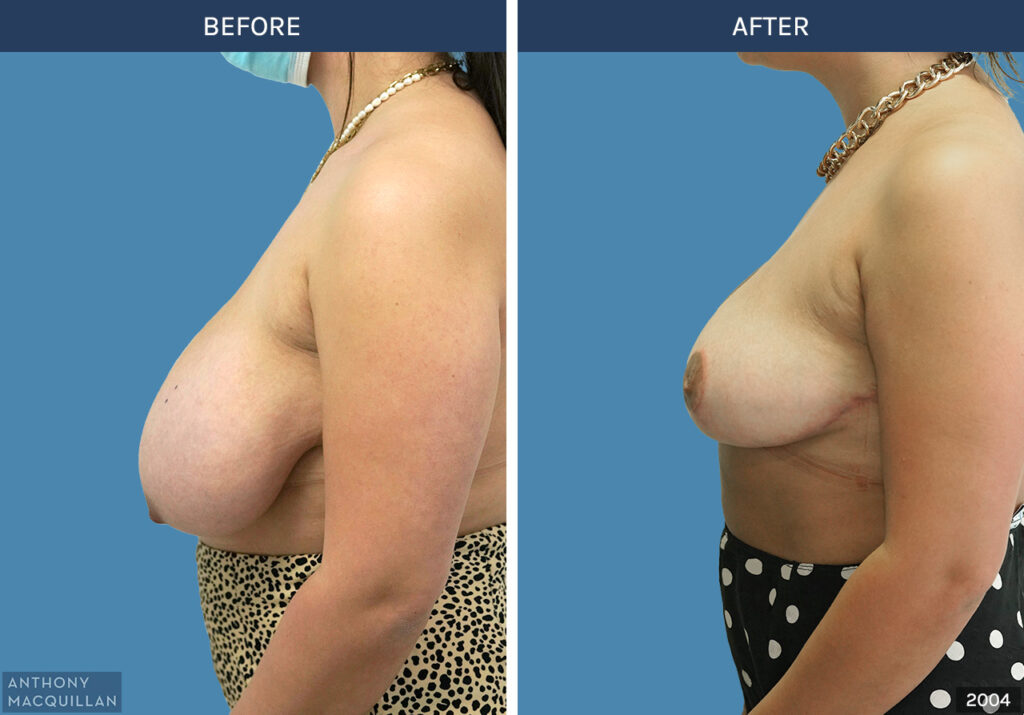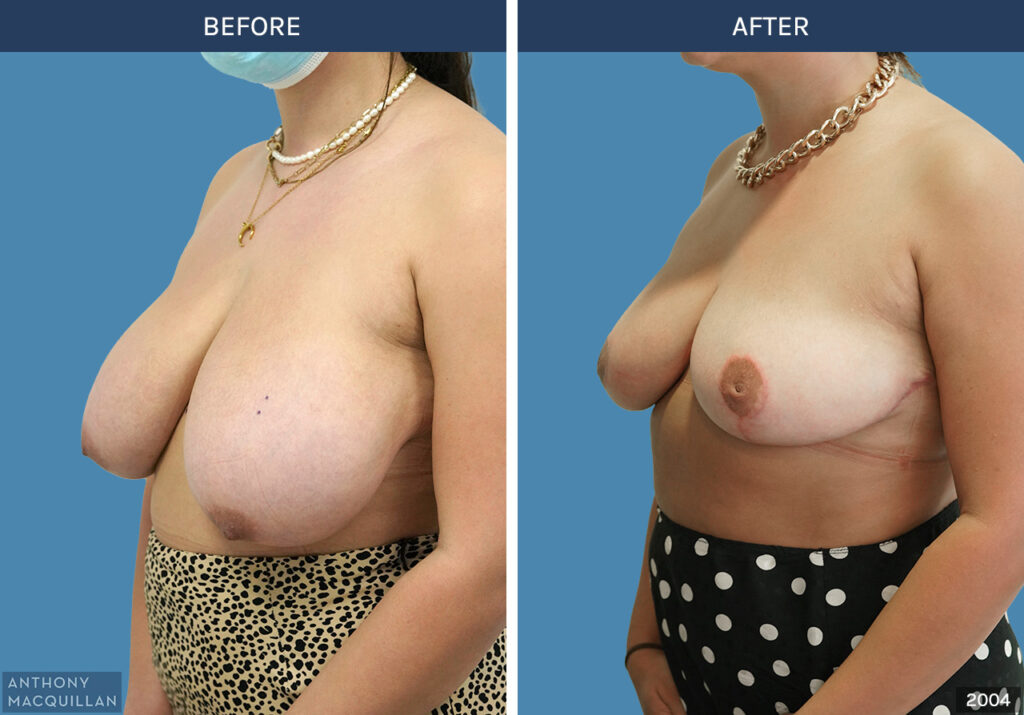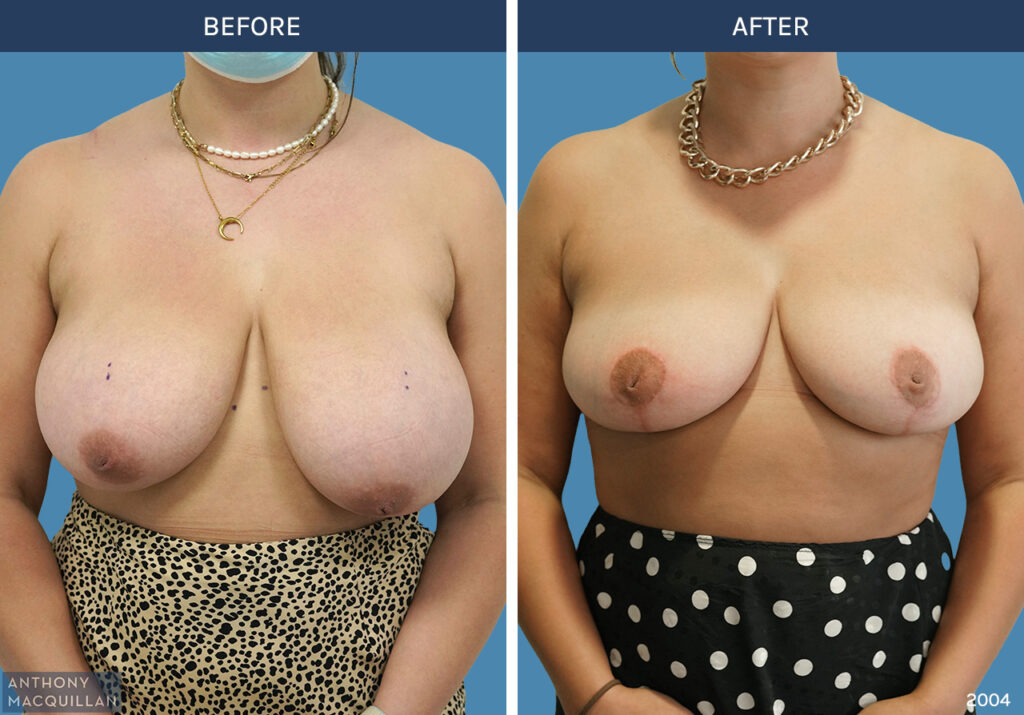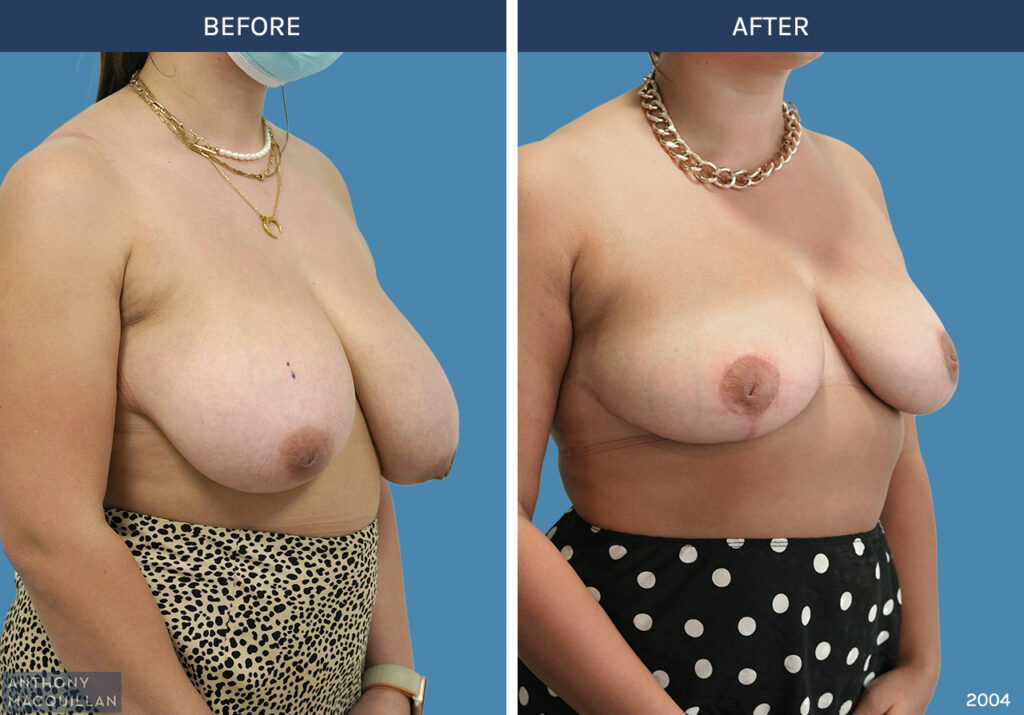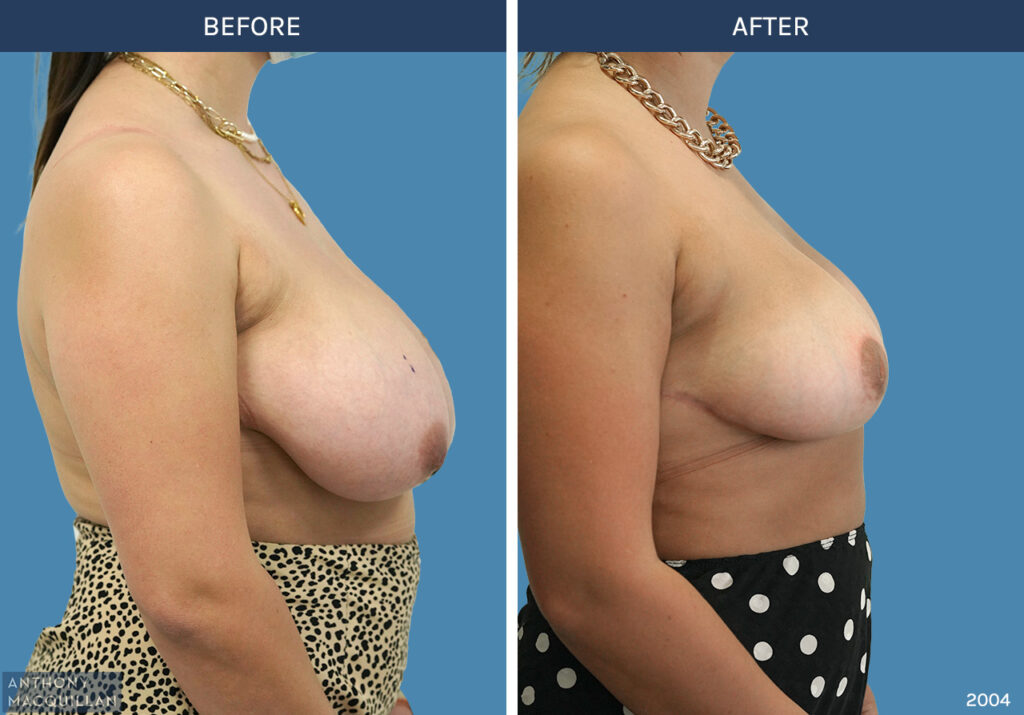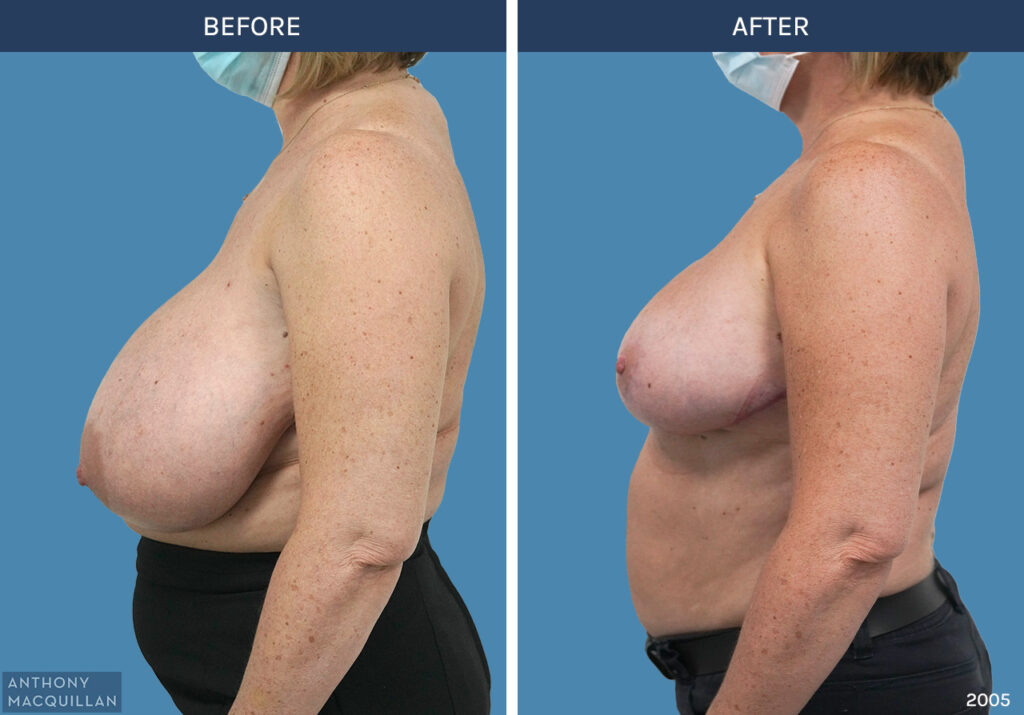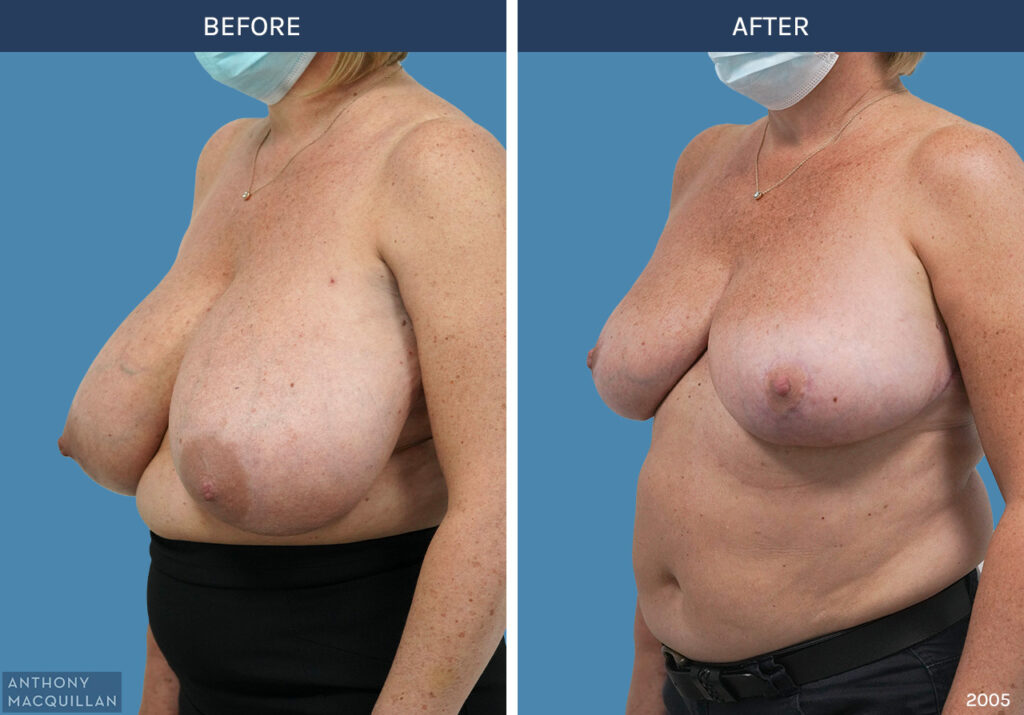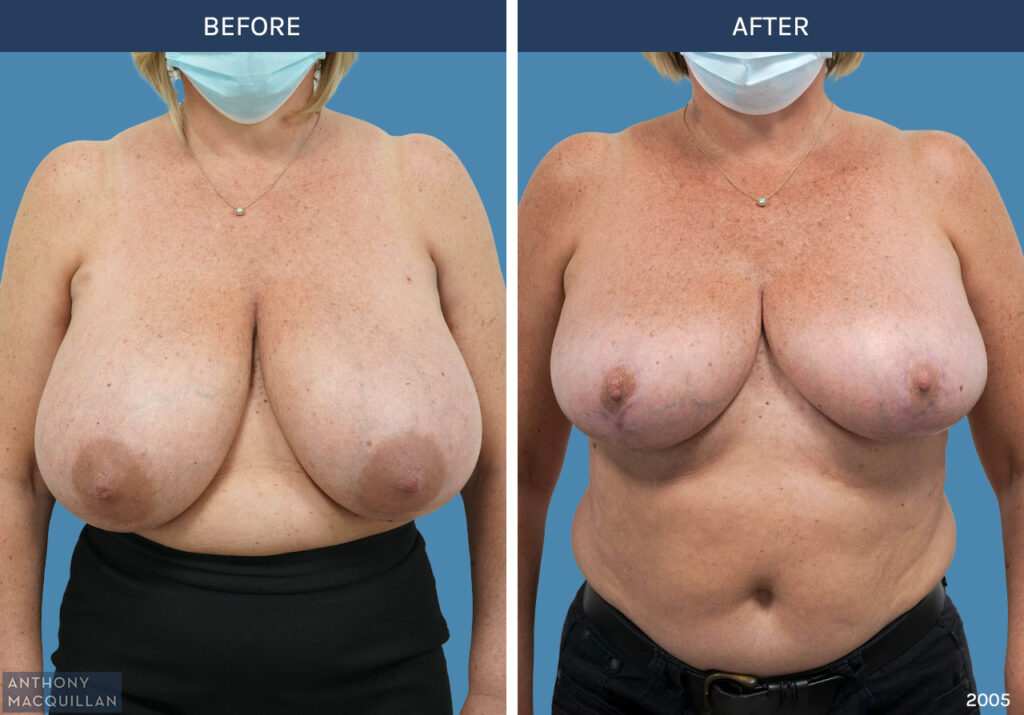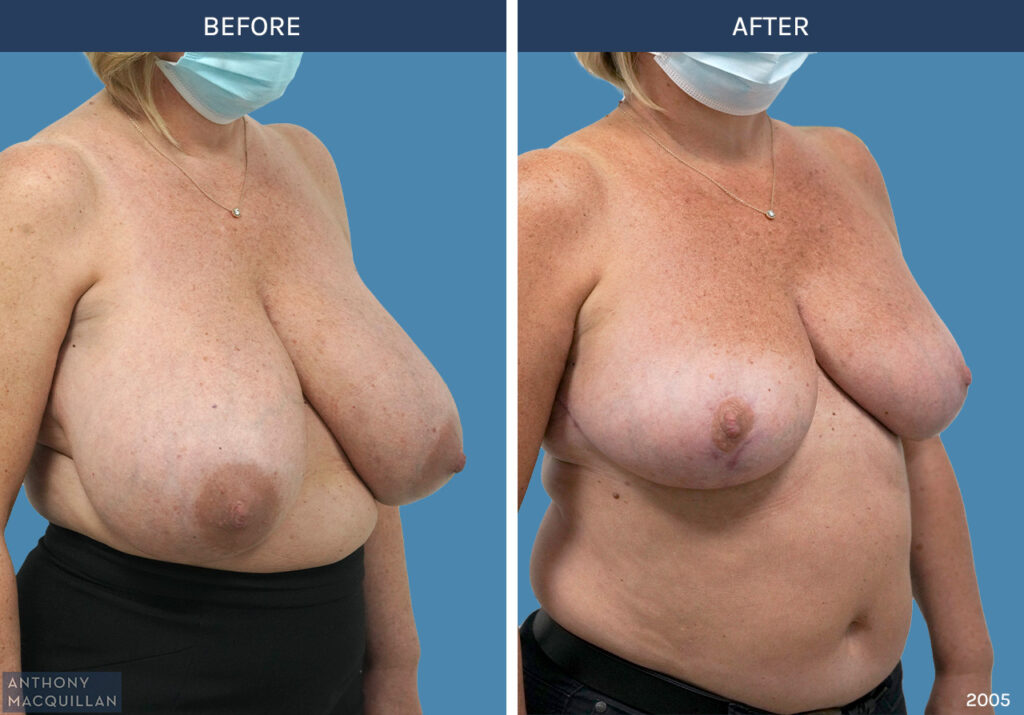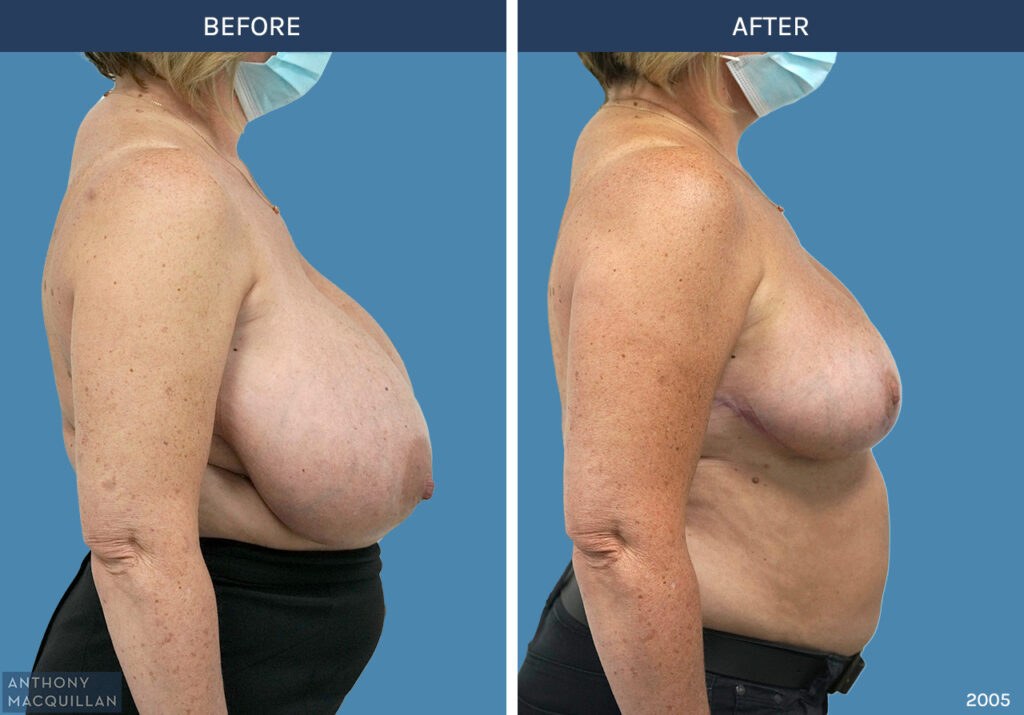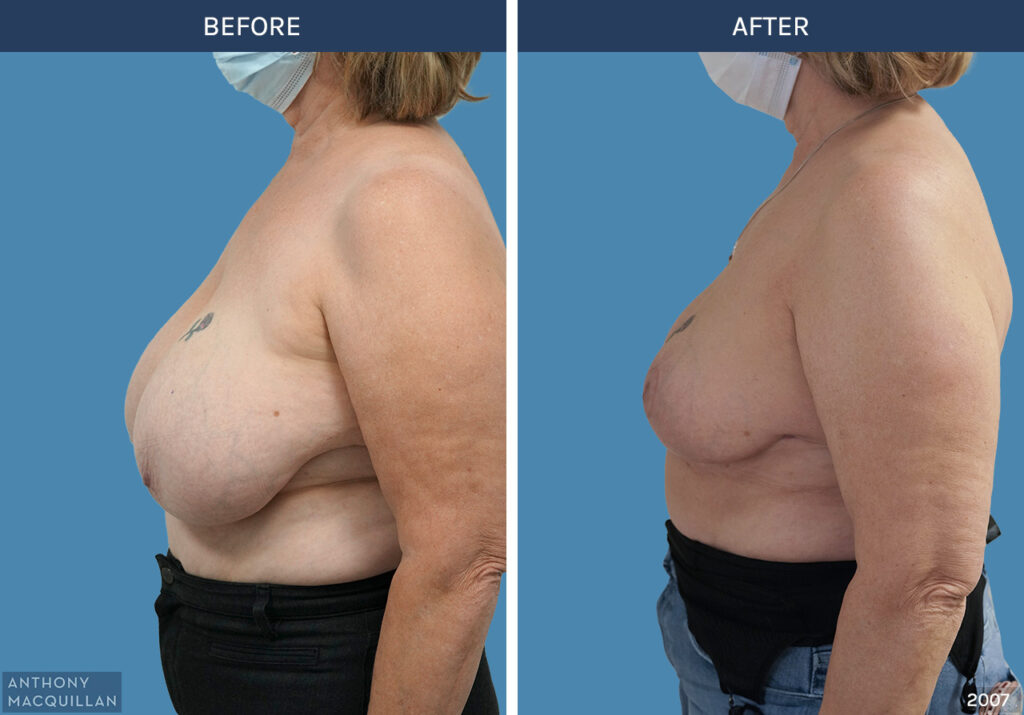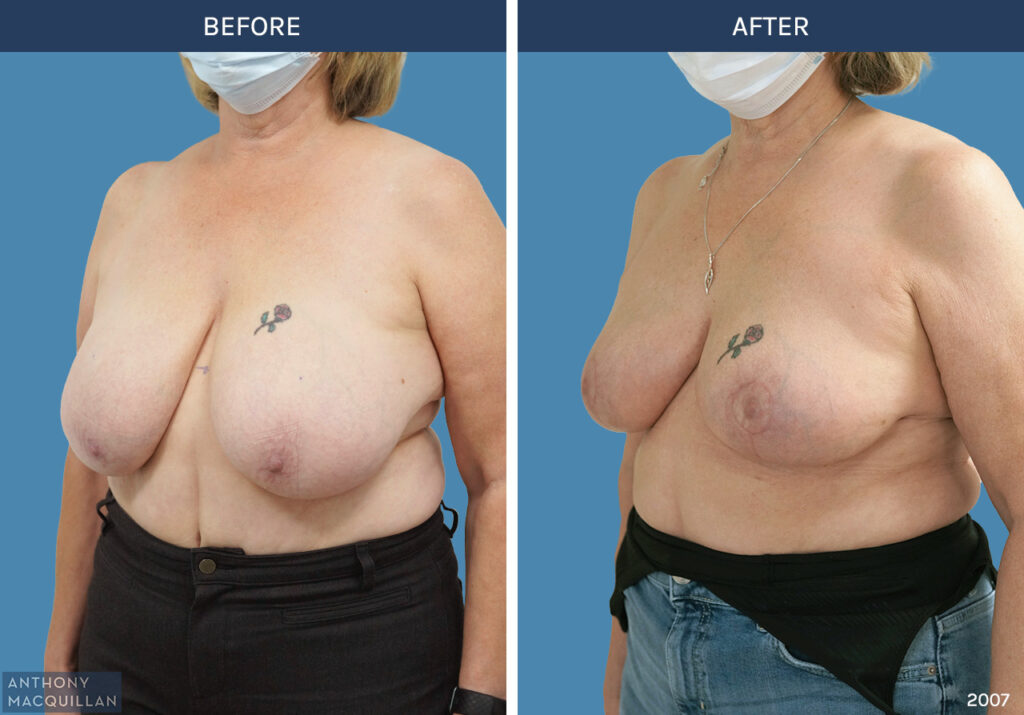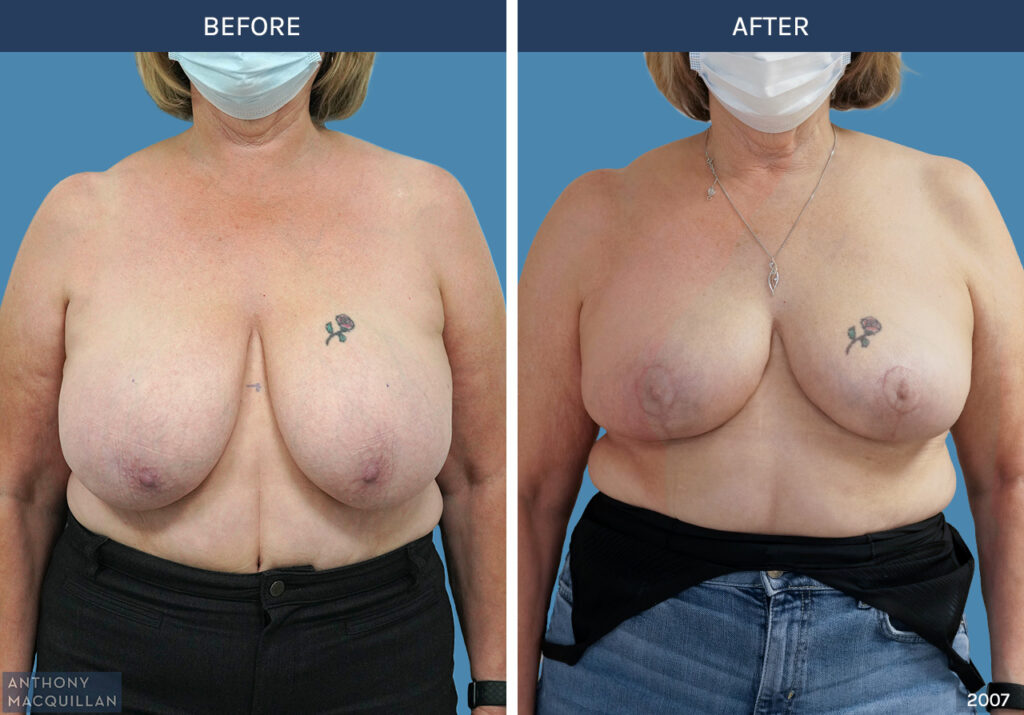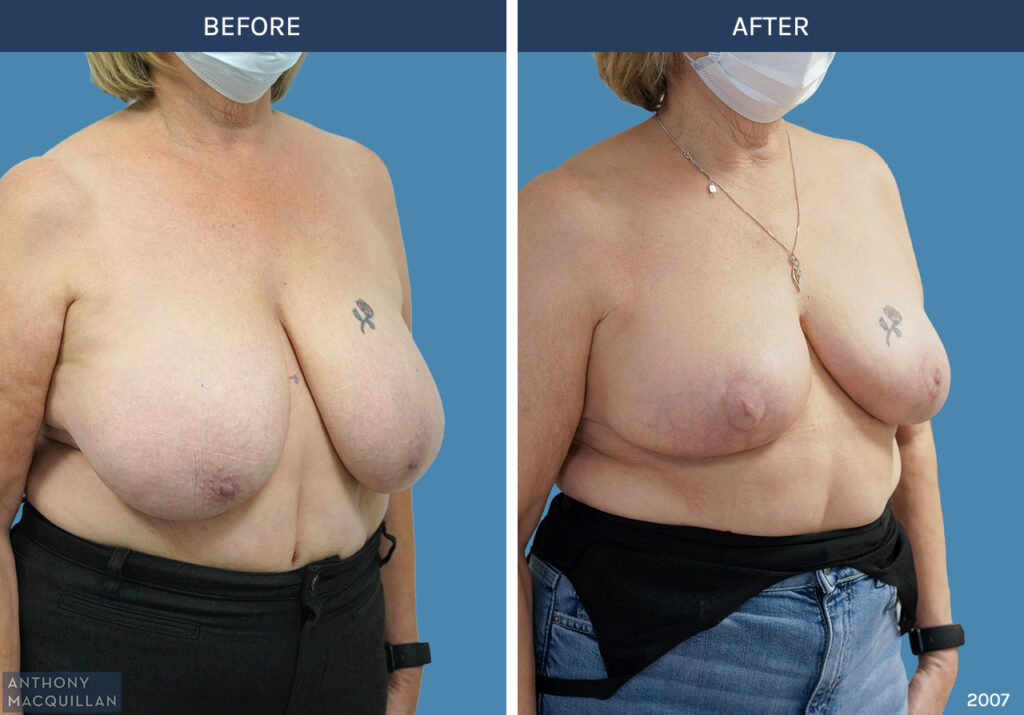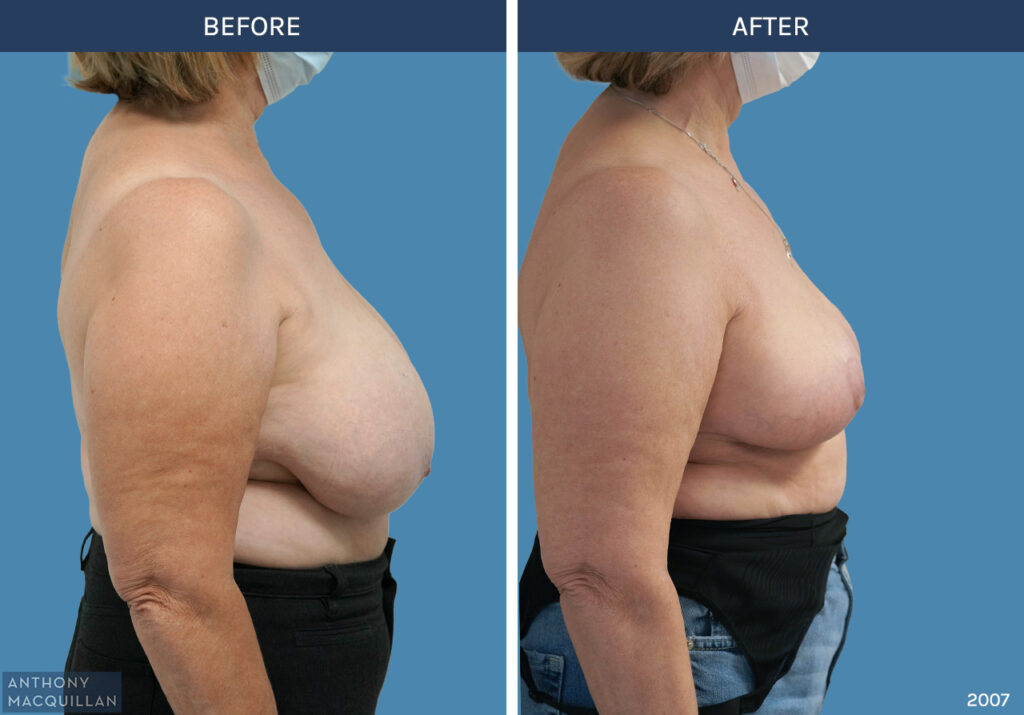Breast Reduction Surgery by Anthony MacQuillan
Breast Reduction is a surgical procedure performed to reduce the size and weight of large, heavy breasts. The surgery involves the removal of excess breast tissue, fat, and skin, reshaping the breast to a size in proportion with your body and alleviating discomfort associated with overly large breasts.
The procedure not only provides physical relief from neck, back, and shoulder pain but also enhances the aesthetic appearance of the breasts, often lifting and firming them.
By addressing both physical discomfort and psychological distress, Breast Reduction surgery can significantly improve quality of life, confidence and self-image.
Consultant Plastic Surgeon Anthony MacQuillan performs Breast Reduction surgery for his patients to help alleviate the burden of large, heavy breasts.
2 to 2.5 hours
General
1 night
6 weeks
You’ll see your results immediately but it can take 6 to 12 months for swelling to subside and surgical scars to fade.
Benefits of Breast Reduction
Breast Reduction surgery, also known as Reduction Mammoplasty, offers numerous physical, emotional, and practical benefits for individuals struggling with disproportionately large breasts. Some of the key advantages include;
- Relief from Physical Discomfort
- Improved Posture
- Enhanced Physical Activity
- Boost in Self-Confidence
- Relief from Emotional Distress
- Prevention of Skin Issues
- Ability to Enjoy Daily Activities
Overall, Breast Reduction surgery offers a transformative solution for individuals experiencing physical discomfort, emotional distress, and lifestyle limitations due to disproportionately large breasts. By reducing breast size and improving breast shape, this procedure can have a profound and positive impact on quality of life and self-confidence.
The procedure often results in a more lifted appearance of the breasts. The areolas can also be made smaller to match the reduction in breast size for more natural-looking results. It typically requires a two to four-week recovery time and is a fairly straightforward procedure.
Can a Breast Reduction Help You?
Breast Reduction is often sought by women who experience physical and emotional challenges due to excessively large breasts.
Candidates for this surgery often suffer from chronic pain in the back, neck, and shoulders, skin irritation under the breast crease, and difficulty engaging in physical activities. Additionally, those who feel self-conscious or face psychological distress due to the attention drawn by their breast size may also consider this procedure.
It is important to have realistic expectations, be in good overall health, and preferably be non-smokers, as smoking can complicate both the surgery and the healing process.
There are several surgical techniques to consider and each has their advantages and limitations, The choice depends on your breast composition, amount to be reduced, and personal preferences regarding incision scars.
Types of Breast Reduction
Traditional Breast Reduction - Anchor technique
This involves an anchor-shaped incision that circles the areola, extends downwards, and follows the natural curve of the breast crease. It is suitable for women with extremely large breasts.
Scarless Breast Reduction
This technique uses liposuction to remove breast fat without making large incisions. It is best suited for women who require a smaller reduction and have a lot more fatty tissue than glandular tissue.
Vertical Incision or Lollipop Breast Reduction
This involves incisions that encircle the areola and extend down to the breast crease – in the shape of a lollipop. It is ideal for women with moderately large breasts and offers a shorter recovery time.
How Is Breast Reduction Surgery Performed?
Surgery is performed by removing breast tissue and skin from below the level of the nipple and then relocating the nipple to a higher point on the breast. It’s performed under general anaesthetic and usually involves a one-night stay in hospital.
Breast Reduction Surgery is a complex procedure that requires meticulous planning and skilled execution. The surgery itself typically lasts between two to three hours. The steps are generally as follows.
- Pre-Surgical Consultation: Prior to the surgery, Anthony conducts a detailed consultation to understand your medical history, desired outcomes, and any concerns. This includes discussing the size and shape goals and examining your breasts to determine the best surgical approach.
- Anaesthesia: On the day of the surgery, you will be administered general anaesthesia to ensure comfort and painlessness throughout the procedure.
- Making the Incisions: Depending on the chosen technique (traditional, vertical incision, or scarless), Anthony makes precise incisions. In traditional and vertical incision methods, the incisions are made around the areola and down each breast. For scarless reduction, small incisions are made for Liposuction.
- Removing Tissue and Reshaping: Excess breast tissue, fat, and skin are removed to reduce the size of the breasts. The remaining tissue is then reshaped to achieve a more aesthetically pleasing contour. In some cases, the areola and nipple may be repositioned to complement the new breast shape.
- Closing the Incisions: Anthony meticulously sutures the incisions, often using techniques that minimise scarring. In some cases, drains may be placed to remove excess fluid and blood.
- Post-Surgical Care: Immediately after surgery, you are taken to a recovery area where you are closely monitored. Pain management and instructions for post-operative care are provided before discharge.
You will have a drain in either breast following the surgery and these are usually removed on the day after the operation.
You will wake up in a ‘microfoam bra’, special medical taping that will help keep your breasts comfortable and supported for the first two weeks after your reduction surgery.
Recovery after Breast Reduction
The recovery period following Breast Reduction is six weeks in total, however, you should only require dressings for two weeks after the operation.
The recovery period following Breast Reduction surgery is essential for ensuring the best possible outcomes. It involves several stages:
- Immediate Post-Operative Period: For the first few days after surgery, you may experience discomfort, swelling, and bruising. Pain medication is prescribed to manage any discomfort. It’s essential to rest and avoid any strenuous activities during this time.
- Wearing a Support Bra: You are usually required to wear a special support bra 24 hours a day for several weeks after the surgery. This helps to minimise swelling and supports the breasts as they heal.
- Activity Restrictions: For the first two weeks, you should avoid bending, lifting, and any strenuous activities. Gradually, normal activities can be resumed, but heavy lifting and vigorous exercise should be avoided for at least six weeks.
- Follow-Up Appointments: Regular follow-up appointments are necessary to monitor the healing process. During these visits, Anthony checks the incision sites, assesses the healing progress, and advises when normal activities can be resumed.
- Scar Care: Scarring is a natural part of the healing process. Anthony may recommend creams, silicone sheets, or other treatments to help minimise the appearance of scars.
- Long-Term Care: Maintaining a stable weight and a healthy lifestyle is important for sustaining the results of the surgery. Significant weight fluctuations can affect breast size and shape.
Please avoid smoking & vaping and performing any strenuous activity during the recovery period for best aesthetic results.
How Much Is Breast Reduction Surgery in the UK?
The cost of Breast Reduction surgery in the UK can vary depending on several factors, including the complexity of the procedure, the surgeon’s experience, the facility where the surgery is performed, and any additional services or procedures required. On average, Breast Reduction surgery in the UK may range from £5,000 to £23,500.
To obtain an accurate price quote for Breast Reduction surgery tailored to your needs, it’s recommended to schedule a consultation with a qualified plastic surgeon. During the consultation, the surgeon will assess your medical history, discuss your goals and expectations, and provide you with a personalized treatment plan, including a detailed cost breakdown.
FAQs
Find out more about your surgical journey
What will my breasts look like afterwards?
After your Breast Reduction, not only will you have lost the weight from your breasts (providing relief to your back and neck) but the uplifting effect of the operation will have improved the shape of your breasts; in essence, reversing the effects of time and gravity.
What can I do after the Breast Reduction operation?
During the six weeks after your Breast Reduction, you will need to modify your activities until you are fully healed.
For the first two weeks, you will need to restrict yourself to light upper body activities, gradually building up to heavier tasks over the following four weeks. You can generally return to the gym after six weeks.
You will not be able to wear an underwired bra for six weeks after your Breast Reduction operation and should buy several well-fitting sports bras to help support your breasts in the post-operative period.
Will my breasts be identical after Breast Reduction?
No one has two breasts that are exactly the same on both sides. Although you will not be perfectly symmetrical following the procedure, breast reduction surgery can often improve breast symmetry.
Any pre-existing asymmetries between your breasts will influence the final outcome of the procedure.
What are the Risks of Breast Reduction ?
Like all surgeries, Breast Reduction procedures have risks and potential complications.
Infections, poor wound healing and changes within nipple sensation are some of the most common risks. However, the prevalence of these is still relatively low. The results may also differ from how you imagined, leading to asymmetry or breast contour irregularities.
Anthony will run through the entire list of risks and complications relating to the procedure during your consultation. He will also provide detailed aftercare instructions to help you get the most out of the procedure and to minimise the risks of complications following the surgery.
For best results, patients should follow these aftercare instructions as strictly as possible.
What are free nipple grafts and when they are used?
Free nipple grafts are when the nipples are removed from the breast completely and sewn back on at the end of the procedure. The reason for doing this is that the size of the reduction in breast tissue required will be too large for the blood supply to the nipple to keep it alive.
By removing the nipple and sewing it back on as a graft, the problems with poor blood supply are overcome (skin tissue that is turned into a graft has a much lower need for nutrients and so can survive long enough for new blood vessels to grow into it). The trade-off is that the nipple usually becomes paler in colour and loses some projection.
Medical References about Breast Reduction
Medical References about Breast Reduction Surgery
- Evaluation of Factors Related to Postoperative Complications in Patients Who Underwent Reduction Mammoplasty
- Study Supports Benefits of Breast Reduction in Teens and Young Women
- Reduction mammoplasty operative techniques for improved outcomes in the treatment of gigantomastia
- Long-term follow-up and patient satisfaction after reduction mammoplasty
- Complications After Reduction Mammaplasty: A Comparison of Wise Pattern/Inferior Pedicle and Vertical Scar/Superomedial Pedicle
Reviews
Patient satisfaction is the top priority for Anthony. You can find how patients feel about his work below.
Outstanding surgeon – my care has been superb throughout
Mr MacQuillan has completely transformed my quality of life, not just a superb surgeon but a really lovely person who takes time to explain things and listens to your wishes. My care has been superb throughout, I chose to have breast reduction surgery because I was in constant pain, my spine was becoming curved and I had constant headaches.
My breasts were reduced from an HH cup to a D cup and I have had no pain at all since surgery and my mobility and quality of life has greatly improved. I think that one of the things that has surprised me most is the fantastic aftercare and not just from Anthony but from his nurse Lucy who has just been outstanding. I am so pleased with the results and I can completely recommend Anthony MacQuillan.


I underwent a breast reduction by Anthony at St Josephs Hospital in Newport. It had taken me some time to come to the decision to look into this surgery as I was very nervous but Anthony ensured that I understood every part of the process before finally making my decision to proceed. My surgery went smoothly and the after care I received from Anthony’s team, Lucy, was outstanding. I couldn’t be more pleased with the results and feel as though I have a new lease of life.


Best Treatment and Service
Where do I start, Anthony was recommended to me by a patient of his, she couldn’t say enough wonderful things about his personal manner and all the before and after care. For my self, the first time I met him I was put at ease, very relaxing surroundings. The whole journey from start to finish was so smooth, I healed perfectly I am still over the moon even after more than 2 yrs post op. Still having follow up appointments even though I’m fine, it’s great incase there’s any questions. I have so much more confidence now, it’ll always be the best decision I’ve ever made.


After loosing 3 stone, I felt very self conscious of my breasts as they were still a large size and had also lost their shape. I was finding it hard to live with them day to day especially with a fast paced job. My interest in a breast reduction further peaked when the pandemic started and I researched many surgeons. Following two consultations with two different surgeons, I felt Mr MacQuillan was the right one for me. From the first consultation, he put me at ease and explained the procedure of a breast reduction step-by-step. I really appreciated being able to see a visual explanation of the procedure. Mr MacQuillan individualises his patients by choosing a technique which would give them the best outcome. He came across as very calm and and I did not feel pressured to make a decision right away. Mr MacQuillan listened to my wishes but also informed me of the risks and likely outcome of the procedure. The staff at St Joseph’s hospital from the surgeon to the nursing staff were absolutely brilliant. I was well looked after and the hospitality was very nice. The after care was simple to follow and I felt back to normal within 2 months. I cannot thank Mr MacQuillan and the staff enough as this was a life-changing procedure and I am very pleased with the outcome.


Excellent Treatment, Care And Aftercare
I went to St Josephs Hospital. My consultant was Mr Anthony MacQuillan ,
My experience of Mr MacQuillan and his team was nothing but excellent.
They all made me feel very relaxed. I had a breast reduction
And I must say I didn’t expect to feel so good so soon after having it done.
My breasts are healing very well .And I really love them.


The operation that I had done was a breast reduction. I have wanted this procedure since going through puberty. After a number of years I considered getting it done and had a few consultations with different surgeons to find out the best one for me.
The main reason that I wanted to get this procedure was because of my job role as a Police Officer. I was previously in the Army and now work in the Police. Due to the amount of kit and equipment I carry, especially with the body armour I knew this was something that was impacting me on a daily basis.
After my consultation with Anthony MacQuillan I felt positive and comfortable with the operation that I wanted to go ahead with. Anthony was very informative and explained everything to me so I had a good understanding of the procedure and the after care.
On the day of the operation I checked into the hospital and was looked after by the staff. Anthony draw on my skin of where the removal was going to be and to make it as symmetrical as possible, after looking in the mirror I was content with this and happy for the operation to commence.
The operation took roughly 2hours 40minutes and I came around from the operation drowsy as expected. The pain was there but the adhesive bandages had been applied to keep them secure and to encourage the healing.
2 weeks afterwards I was able to have the bandages removed and able to see the magic that had been performed. I was really happy with the outcome, the breasts were symmetrical and the scarring was healing well with no signs of infection. Anthony and the nurse were also happy with the healing so far. At this point I was able to now wear a post-surgical bra which I purchased from M&S and tape was applied around the scar area. I would change the tape every 4-5 days.
Around a month later after surgery I then had a further follow up appointment with Dr MacQuillan who was extremely happy how everything had healed and so was I. He took photos and compared to my ‘before’ photos there was a massive difference! The size was what I was after and Dr MacQuillan had listened to what I was after as a patient and delivered.
I would 100% recommend Anthony MacQuillan to anyone looking to have a breast reduction and I wouldn’t hesitate if I was to want any further procedures done by Anthony. The procedure has definitely made my job more comfortable and I am more confident in myself after having this procedure done. I am awaiting one more appointment and then I can separate ways from the post-surgical bra! Thank you again Anthony.


My Surgeon is Absolutely Fantastic I Know I Will Have a Great Job Done.
After having a tummy tuck in April 2017 with Mr MacQuillan he was so supportive before during and after he was so professional I’ve decided to go back and have breast reduction done. It’s booked for a few weeks time which I’m so excited about because I know I’m in safe hands.


After suffering with extremely large breasts since my early 20’s and suffering from severe back pain. I decided to JUST research breast reduction. However, after my first consultation with Mr MacQuillan I felt so confident, he answered all my questions and concerns I had and completely put my mind at ease. All risks were fully explained to me, but I was reassured throughout and I immediately decided to proceed. My only regret is that I did not have breast reduction 30 years sooner. He paid attention to every detail. I cannot thank him enough for the amazing outcome. A big thank you to Lucy who helped me through this journey. I would HIGHLY recommend Mr MacQuillan. THANK YOU SO MUCH X


Better than I could ever imagine
After thinking about a breast reduction for about 20years a friend told me about Mr MacQuillan. I looked him up via the internet and booked a consultation. After meeting Mr MacQuillan I decided straight away i wanted to go ahead with the reduction. He was so easy to talk to, everything was explained in detail, I wasn’t rushed into making a decision. I told him what I would like and he was realistic with the results that could be achieved. I can say they are fantastic results. The pre and post operative care was excellent, both by Mr MacQuillan and the hospital staff. I would recommend Mr MacQuillan to anyone. I am so very pleased with my results, better than I could ever imagine. I feel fabulous.


I am SO happy I chose Anthony for my surgery. From my initial consultation, to my surgery day and during aftercare he went absolutley above and beyond to make sure I was well informed, happy and comfortable. I felt totally at ease and the process couldn’t have gone more smoothly. His kind manner made me feel able to ask as many questions as I wanted (I had lots!)
I also felt that he really listened to me and that I was in safe hands – which is so important to me as a patient.
I am absolutely thrilled with the results of my surgery (breast reduction) and Anthony’s work totally exceeded my expectations – it has really changed my life forever. I am so thankful to Anthony and the amazing team who looked after me.
I couldn’t recommend him enough! 5 stars doesn’t seem like enough!


Outstanding Surgeon, very informative, friendly, superb aftercare from whole team!
Fantastic experience with Mr MacQuillan, from the very first appointment, to the surgery and aftercare has been the best care I could have wished for. He made me feel very comfortable about having the surgery done, I was quite nervous, but he covered every concern clearly and I totally understood what was being done. I had a breast reduction and must say it is the best thing I have ever done, I had read many review from many different surgeons and decided on Mr MacQuillan based on his excellent reviews, location and aftercare. I cannot recommend Mr MacQuillan enough, felt in very safe hands, and my results are fantastic just what I wanted.


I couldn’t recommend Anthony enough!
I am beyond thrilled with the results of my breast reduction and the procedure has changed my life. Anthony made me feel comfortable throughout the process and explained in detail the risks and achievable results of the operation, allowing me to be fully informed when making my decision. All of the staff at the Bath hospital were caring and welcoming and I have received good aftercare!


65 Years Old and I Needed Help! – Bristol, GB
I am a 65 year old woman and have suffered for many years with my breast size and have subsequently been desperate to have surgery to help alleviate this problem. After much research, I decided to book an appointment with Anthony MacQuillan who took me through the procedure with the care and attention required for such an invasive operation. Understandably I was concerned about the pitfalls of the surgery, however, he was excellent from my first meeting – he was reassuring but most importantly -up front and honest. I can genuinely say both Anthony and his team have changed my life; I feel liberated and able to go about my day with new vigour. With regards to pre and post-surgery care, their service is second to none and worth every penny and I would heartily recommend and urge anyone with the same problems to get in touch.


When deciding upon breast reduction surgery, the choice of surgeon was top of my list of research. Mr MacQuillan did not disappoint. From my very first meeting with him, Mr MacQuillan put me ease and had a first class ‘bedside manner’. Prior to the surgery I had 2 consultations, during which the procedure and potential problems were explained fully and thoroughly. Mr MacQuillan ensured I had a full understanding, that I had the opportunity to ask any questions and also had time to reflect upon my consultations before making a firm decision to go ahead with the surgery. I am now 6 weeks post op and am thoroughly pleased with the results. I really could feel the benefits of my surgery immediately. The post operative follow ups to date have been fantastic. 1 week following the removal of my dressings I became slightly concerned about an area of skin tissue that did not seem to be healing. Mr MacQuillan had no qualms whatsoever in seeing me straight away to allay any concerns that I had. For anyone considering bi-lateral breast reduction surgery, I would most certainly recommend Mr McQuillan. I am eternally grateful for how he has made me look and feel. Thank you.


I’ve recently had a breast reduction done by Dr Anthony MacQuillan. Lovely man and very passionate about his work. I knew i was in safe hands from the first day i met him. I am a very happy woman …a changed woman at that , and i would highly recommend this fantastic surgeon. Excellent care before and after surgery amazing results and always at the end of the phone if needed.


I recently had breast reduction surgery performed by plastic Surgeon Anthony MacQuillan, at the Spire Hospital in Bristol.
From start to finish the whole process was professional but also incredibly personal.
I was made to feel very at ease and that I was in very safe and caring hands.
I cannot speak highly enough of Anthony MacQuillan, he explained the whole process completely , whilst listening to what my expectations were. My results are amazing, much better than I had hoped for, my only wish is that I had know about him sooner.
I highly recommend him , for his skill , and professionalism as a plastic surgeon.
Jayne Tufft


I am an 18 year old who has suffered with abnormally large breasts since the age of about 12/13. As soon as I turned 18 I took the opportunity to have cosmetic surgery on my breasts in order to reduce them in size. I had the pleasure of being assigned to Dr MacQuillan as my consultant and from our initial meeting he made me excited and extremely comfortable with the idea of having my breasts reduced. I understood that there can never be a perfect reduction and that there would be some flaws, but Anthony managed to defy all of my expectations. It has been an extremely life changing surgery and I can’t thank him enough for how he has so drastically changed my life for the better.


From my first appointment with Anthony I felt safe and secure in going ahead with my breast reduction. This is the best thing I have ever done and Anthony has completely changed my life, they are better than I could have ever imagined. He is very caring, understanding and gives clear explanations of the whole operation and recovery. He has given me what I never thought was possible.
I cannot thank him enough.


From my very first contact with Mr MacQuillan my experience has been fantastic,
Mr MacQuillan went through in great detail the surgery that I was looking to have, I wanted breast reduction and had looked at lots of reviews from different people after breast surgery, I needed to know I was with the right surgeon and I knew exactly what was to happen, I had many questions and was very apprehensive
about how the surgery would come out, I was thrilled with the results, Mr MacQuillan was very supportive both before and after surgery, and have been back and forth to the hospital quite a few times for the dressings and review of my surgery.
I would thoroughly recommend Mr MacQuillan for Breast Reduction surgery, it is a big operation and you need to know exactly what it entails and want to make sure that your result is just what you want, I am delighted with the results, everyone said it would change my life, and it certainly has.
Margaret and the team at St Josephs were also amazing and were so easy to talk to if I had any questions, the aftercare has been brilliant.

Why Choose Anthony?
Anthony’s expertise in breast surgery is complemented by an all-inclusive approach to patient care. We understand the importance of listening to your concerns, desires, and expectations, ensuring a journey that is as comfortable and reassuring as possible. From the initial consultation through recovery, our team is dedicated to supporting you every step of the way.
State-of-the-Art Techniques and Facilities: We use the latest surgical techniques and technologies to ensure optimal outcomes and minimal downtime.
Personalised Care: Each procedure is tailored to meet the individual needs and goals of our patients, ensuring results that are both beautiful and natural-looking.
Comprehensive Support: Our team provides comprehensive care, from pre-operative education to post-operative support, ensuring your experience is positive and fulfilling.
Getting Started
Your journey toward confidence and well-being begins with a consultation. During this meeting, Anthony will discuss your aesthetic goals, evaluate your health, and recommend the best treatment options for you. Together, we will craft a personalised plan that aligns with your vision and lifestyle.
To learn more about our procedures or to schedule your consultation, please contact us today.
Further Reading about Breast Surgery with Consultant Plastic Surgeon Anthony MacQuillan
Learn more about procedures Anthony preforms, including;

